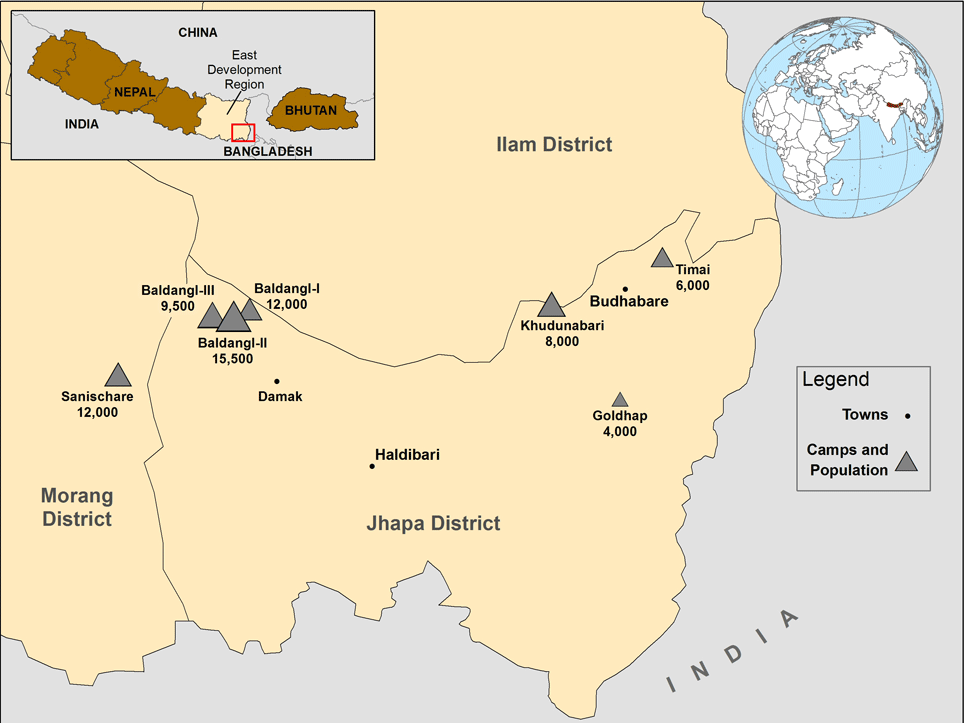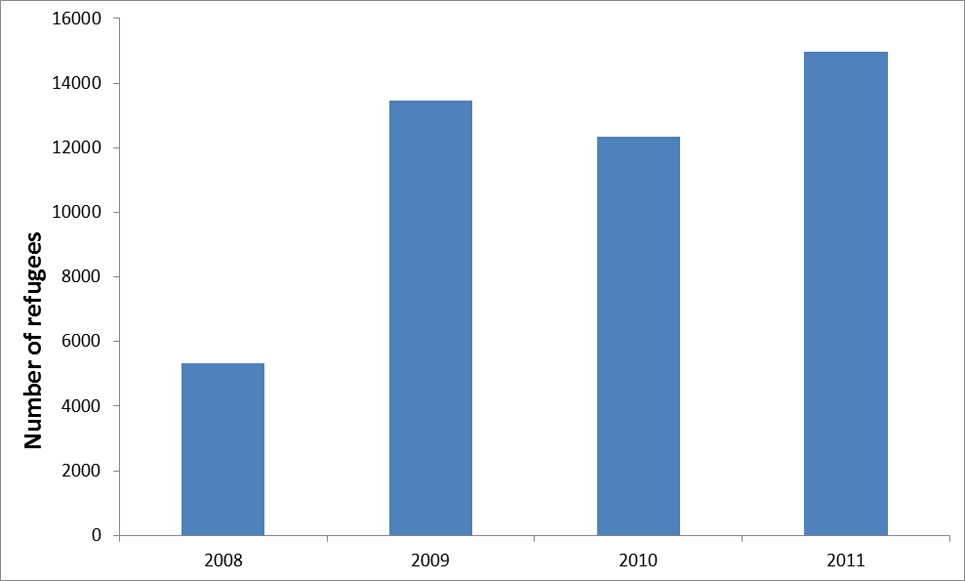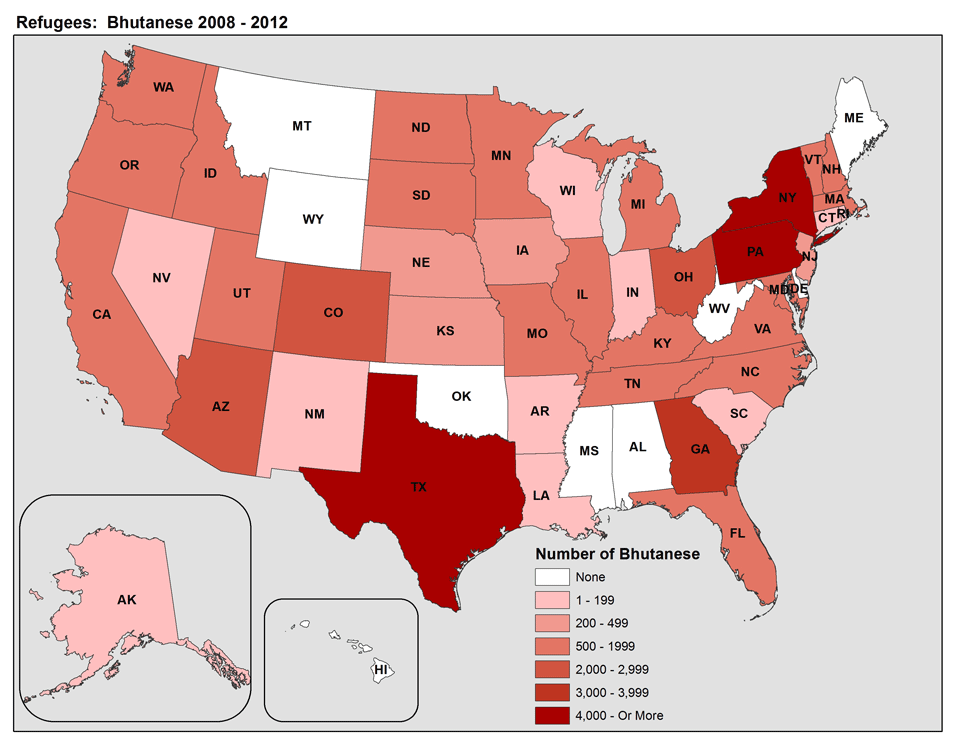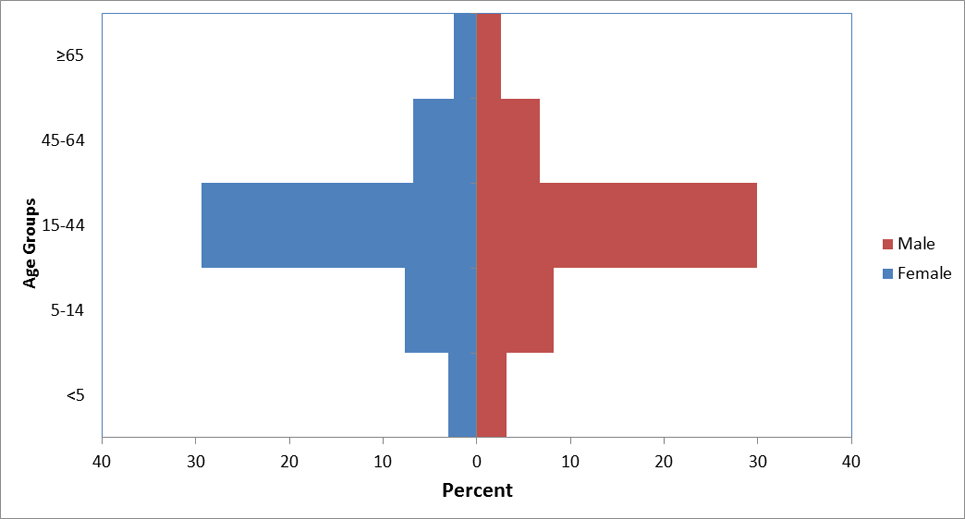Population Movements
Bhutanese Refugee Health Profile
To Nepal
In the early 1990s, more than 100,000 ethnic Nepali left Bhutan and resettled into seven refugee camps in southeast Nepal: Beldangi I, Beldangi II, Beldangi II extension, Goldhap, Khudunabari, Timai (all in Jhapa District), and Sanischare (Morang District) near the township of Damak (Figure 2). Nearly all Bhutanese refugees in Nepal reside in these refugee camps, as opposed to an urban setting. In 2006, the United States and other governments began to offer resettlement to Bhutanese refugees living in these camps. 2 As of early 2012, more than 49,000 Bhutanese refugees have been resettled to the United States. 8 Smaller numbers have been resettled to Australia, Canada, and other countries. Since 2006, the camp population decreased by nearly 40%, but as of 2011, approximately 67,000 refugees remain, including 5,800 children under 5 years of age. Due to the decline in camp populations, in February 2011, the Nepalese government expressed the intent to consolidate the camps into two settlements. Of the seven original camps, two (Timai and Goldhap) have been closed and the remaining population moved to Beldangi and Sanischare. The last camp of the Eastern group, Khudunabari, will be relocated in March–May, 2012. Three Beldangi camps (Beldangi I, II, and II extension) are now collectively named Beldangi (though all three remain), and Sanischare remains. By the end of May 2012, there will be two official camps – Beldangi (three camps in one) and Sanischare. 5
Figure 2. Location and size of Bhutanese refugee camps in Nepal (April, 2011)

Source: Kevin Liske, DGMQ, CDC And Health Information System (HIS)
To the United States
From 2008 to 2011, between 5,000 and 15,000 Bhutanese refugees arrived annually in the United States (Figure 3). A similar number is anticipated in 2012 as the United States “remains committed to considering for resettlement as many refugees as express interest”. 7 Refugees have been resettled to 41 states, with Pennsylvania, Texas, New York, and Georgia each receiving ≥ 7% of total arrivals (Figure 4). 8 However, once refugees arrive in a state, they are free to relocate elsewhere, and secondary migration to join an already established Bhutanese community is common. Most (60%) Bhutanese refugees resettled to the United States are young adults aged 15–44 years, 15% are 45–64 years old, 5% are 65 years or older, and the remainder are children under 15 years old (Figure 5).
Figure 3: Bhutanese refugee arrivals to the US, FY 2008-FY 2011 (N=46,069)

Figure 4: State of primary resettlement for Bhutanese refugees, FY 2008-FY 2012 (N=49,010)

Table 1: Top 10 States of primary resettlement for Bhutanese refugees
| Top 10 States (https://www.cdc.gov/immigrantrefugeehealth/profiles/bhutanese/population-movements/index.html#star)* | Number | Percent (%) |
|---|---|---|
| Pennsylvania | 4909 | (10.0) |
| Texas | 4873 | (9.9) |
| New York | 4000 | (8.1) |
| Georgia | 3446 | (7.0) |
| Ohio | 2335 | (4.7) |
| Arizona | 2329 | (4.7) |
| Colorado | 2117 | (4.3) |
| Washington | 1944 | (3.9) |
| Virginia | 1883 | (3.8) |
| North Carolina | 1671 | (3.4) |
* The remaining 19,503 refugees resettled to 31 other states. Source: WRAPS
Figure 5: Demographic characteristics of Bhutanese refugees resettled to the United States, 2008-2011 (N=48,846)

Source: Electronic Disease Notification System (EDN)
References
- Commonwealth of Australia. Bhutanese community profile. 2007. http://www.immi.gov.au/living-in-australia/delivering-assistance/government-programs/settlement-planning/_pdf/community-profile-bhutan.pdf[PDF – 28 pages]
- International Organization for Migration (IOM).
- Presidential Determination No. 2009-32, Sep 2009.
- US Department of State, Bureau of Population, Refugees, and Migration (PRM), Worldwide Refugee Admissions Processing System (WRAPS).
- Page last reviewed: June 22, 2012
- Page last updated: February 24, 2014
- Content source:


 ShareCompartir
ShareCompartir